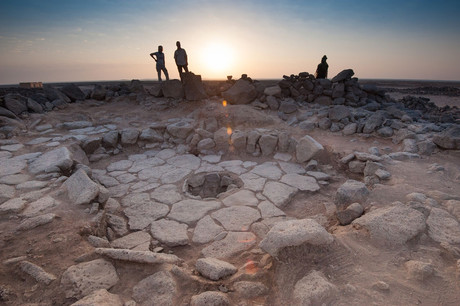It's got to be stale

A bit like which came first, the chicken or the egg?, the question which came first, plant cultivation or baking? looks like it has been solved. Archaeologists in north-eastern Jordan have discovered the remains of bread that predates agriculture by 4000 years.
The charred remains of a flatbread baked by hunter-gatherers 14,400 years ago is the oldest direct evidence of bread found to date. The findings suggest that bread production based on wild cereals may have encouraged hunter-gatherers to cultivate cereals, and thus contributed to the agricultural revolution in the Neolithic period.
The discovery by a team of researchers from the University of Copenhagen, University College London and University of Cambridge provides the earliest empirical evidence for the production of bread. Wild ancestors of domesticated cereals such as barley, einkorn and oat had been ground, sieved and kneaded prior to cooking the flat bread and this shows that baking came before plant cultivation.
“Bread involves labour-intensive processing which includes dehusking, grinding of cereals and kneading and baking. That it was produced before farming methods suggests it was seen as special, and the desire to make more of this special food probably contributed to the decision to begin to cultivate cereals. All of this relies on new methodological developments that allow us to identify the remains of bread from very small charred fragments using high magnification,” said Professor Dorian Fuller (UCL Institute of Archaeology).
The charred food remains were analysed with electronic microscopy at a University College London lab by PhD candidate Lara Gonzalez Carratero (UCL Institute of Archaeology), who is an expert on prehistoric bread.
Carratero explained, “The identification of ‘bread’ or other cereal-based products in archaeology is not straightforward. There has been a tendency to simplify classification without really testing it against an identification criteria. We have established a new set of criteria to identify flat bread, dough and porridge like products in the archaeological record. Using scanning electron microscopy we identified the microstructures and particles of each charred food remain.”
The team’s research has been published in the journal Proceedings of the National Academy of Sciences.
Metal detection selection to support food safety
Metal remains the most likely contaminant risk encountered in food processing and packing...
Improving shelf life of blueberries with upcycled edible coating
A team of chemical engineers from UNSW Sydney are working to extend the expiry date of packaged...
Beverage maker deploys service-based power supply model
Purearth Foods is leading the way as the first software-led UPS deployment in ANZ beverage...











